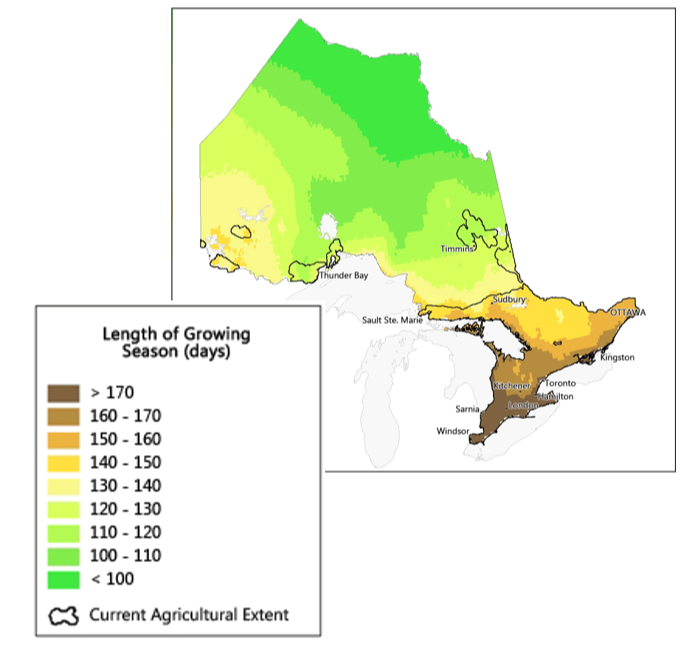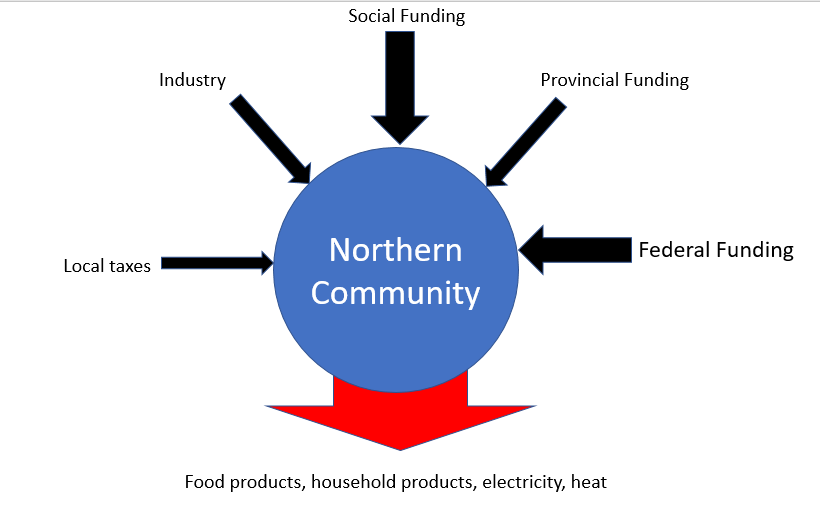
For many Canadians, the seasonal challenges and extreme weather conditions gives rise to unique problems that are rarely experienced in other parts of the world. Extremely cold temperatures and limited sunlight hours in the winter has created community dependency on outside sources of sustenance, energy and other products.
When we consider sustainability, the definition we use is from the Brundtland Report of 1987, which stated “Sustainable development is development that meets the needs of the present without compromising the ability of future generations to meet their own needs” and as well, the typical definition which is states sustainability as “the ability to be maintained at a certain rate or level”.
After examining the economies of northern communities, it may come as a surprise that the current system is not sustainable. Our conclusion has been derived from several pieces of information, but rather than drag on the details, let’s focus on the key components of the current system:
- Food imports
- Energy imports
- Common Goods Imports
- Building & equipment imports
- Limited economic activity
As suggested by the list above, there is very little that that northern communities actually produce. With the decimation of traditional hunting and gathering in many communities, food production has been replaced with food imports. This problem is not limited solely to northern communities, but is actually a trend that is predominant across Canada. During the winter months (and in some summer months), Canada imports fruits and vegetables from the United States and Mexico. While Canada enjoys a trade surplus in agri-products, this fact can be misleading, as the majority of Canada’s exports are limited to seafood, wheat, lentils, soybeans and durum wheat. For northern communities, there is a much higher trade imbalance as many of these communities are unable to grow food throughout the year. In Ontario, for example, the growing season for most of the north is limited to less than 120 days per year.

The issue of local food production is limited by both temperature and solar insolation (radiation), as most of northern Canada experiences fluctuating temperatures throughout the year, and as well, lower solar radiation during the winter months.
Energy Imports:
Because of the challenges regarding temperatures in northern communities, the obvious solution would be to provide the heating and light requirements through common sources of energy like electricity. Unfortunately, many northern communities rely on diesel powered generators and are either at capacity during the winter months, or due to economical reasons cannot afford the additional electrical load.
It should be noted that the majority of northern communities import their energy – through grid connected electricity or the importation and burning of fossil fuels. This issue of energy dependence adds to the problem of food insecurity and is something that must be solves simultaneously with any proposed solutions.
Common Goods Imports
Most northern communities have not developed the industry and infrastructure to support the local needs of their communities. One of the interesting trends that has arisen is the prominence of online purchasing sites, such as Amazon. Due to the extremely high cost of transportation in these communities, the use of amazon’s services such as amazon prime has increased. While this has become a temporary solution in some communities, the underlying fact remains that many northern communities cannot support their residents in terms of household needs; everything from bed frames to household furniture.
The reason this remains an issue (from our point of view), is that is exacerbates the economic conditions that many residents of northern communities face. The high cost of commonly used materials decreases the amount of expendable income that individuals and families have, which in turn, limits the amount of healthy food or heat they can purchase.
Building & Equipment Imports
As far as we know, there are literally no manufacturing facilities in northern Canada. One of the underlying issues facing traditional hunting and gathering is the high cost of fuel and ammunition. While these are operational expenses, the tradition of using dog sleds or other means of traditional transportation has been replaced with snowmobiles and motorboats. This has led to an increase in the capital costs of outfitting hunting equipment, as well as the operating expenses, as prior to the implementation of fossil fuel based equipment, the traditional mode of transportation was largely driven by renewable sources, such as paddling.
Due to the high cost of transportation, the quality of northern housing is also affected. As the costs increase for simple shipments, some buildings are constructed poorly or without the requisite thermal efficiency built in. This not only leads to poor living conditions, but also increase operating expenses, as more is spent to ensure that a house is heated. This in turn leads to increased economic dependency and poverty as the electricity and other sources of heat are extremely costly.
Limited economic activity; Limited income
Depending on the location of northern communities, in particular, to the proximity of these communities to resource extraction projects & activities, many northern communities suffer an acute lack of economic activity and therefore, limited household income. Even communities that have resource project in close proximity are subject to fluctuating global markets and the boom or bust trend of commodities. The result of this limited economic activity has resulted in an enormous economic disparity between northern residents and their southern counterparts. It is important to note that while revenues may differ between southern and northern individuals, the key component to measure is expendable income, which is the amount of income that the owner has complete discretion over its spending.
For example, in a community in Northern Ontario, the average Ontario Works payout is $693 for a single person. This same person is forced to pay around $350 for rent (which is subsidized in the community that he lives in) and as well, around $200 per month for electricity (averaged over the course of the year). In addition, the cost of groceries to eat, fuel for his/her vehicle and insurance essentially means that this person cannot afford to live. It is extremely unfortunate, because the person in this example is actively seeking employment, and it is solely based on his/her geographic location, rather than the person’s ability that determines the amount of work he/she can garner.
In conclusion
Essentially, northern communities can be analyzed as businesses. They have a recordable amount of imports and exports. Unfortunately, exports are limited, but there are ways that he imports can be limited. We prefer to view communities as “open systems” which essentially shows the magnitude and direction of economic activity in a community.

As you can see from the figure above, we want to limit the “red” losses and replace them with discernable income for community members. For example, instead of purchasing electricity for heat, the community could employ community members to provide a sustainable source of biomass. This would not only lower the community’s carbon footprint, but would also lead to sustainable economic activity.
ASM’s view is that there are innumerable ways in which communities can become more efficient and sustainable. Our purpose is to provide solutions in areas where we see the largest problems and to make sure those solutions are implemented correctly.
